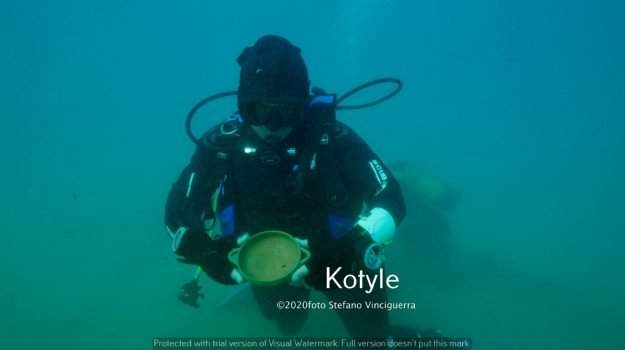Sicily: Greek artifacts from the 6th century BC found in the sea at Gela.
New archaeological finds have been unearthed in the sea at Gela. These areancient Greek objects dating from the 6th century B.C. that include a kotyle and a skyphos, typical Greek drinking cups with two horizontal handles: one with a shallow bowl, the other deep, both achromatic (not colored). Along with them there is also a stone architectural fragment consisting of a square base on which is set a small column with a circular base, lacunose at the top. The discovery of these objects comes from the contrada Bulala where workers from the Sicilian Region’s Superintendence of the Sea unearthed these valuable finds.
The state of preservation at the moment does not allow to say anything else, except that the small size could refer to a shipboard statuette, personal property of a crew member. “Once again Gela is confirmed as a treasure chest that tells an important part of our ancient history,” says Sicilian Regional President Nello Musumeci. “The discovery, by the Superintendence of the Sea, demonstrates the constant commitment carried out by the Region. It is confirmation of how my government keeps a high level of attention on the Gelese territory, which I believe to be a precious container of archaeological evidence. Therefore, the work of valorization of an area continues with interventions that can provide an opportunity for cultural and social redemption to an area that for too long has been mortified.”
“The action carried out by the Superintendence of the Sea with the fundamental contribution of the Guardia di Finanza, the Port Authority and the diving associations,” says the councillor for Cultural Heritage and Sicilian Identity, Alberto Samonà,“continues unceasingly on several fronts: on the one hand there is the investigative activity that leads to sounding the seabed in search of ever new evidence and finds, and on the other hand there is the supervisory activity with the constant work of reconnaissance and protection of the areas to ensure even the illicit removal of finds. Sicily plays a very important role worldwide in underwater research, an area in which Sicily has achieved internationally acclaimed results. In fact, underwater archaeology, in addition to its scientific profile, assumes great value for the potential it offers as a very special segment of the cultural-tourist offer.”
The research mission was coordinated by Stefano Vinciguerra, head of the Underwater Group of the Superintendence of the Sea, who, in recent days, taking advantage of the good visibility conditions of the sea went to the area of Gela, in the “Bulala” locality, for the photographic documentation and three-dimensional survey of a submerged tank, which, however, turned out to be covered by at least one meter of sand, which made the undertaking in vain.
The impossibility of filming shifted the search to a nearby area where an iron anchor, half sunk into the sandy seabed, was located, near which an intact fictile bowl and a portion of a marble column with relief figures, as well as minor finds were detected, which were taken in view of the high risk of theft.
“Despite the objective difficulties due to the poor visibility of the sea of Gela,” emphasizes Superintendent of the Sea Valeria Li Vigni, "each intervention of the SopMare divers manages to give us new emotions and discoveries every time. Thanks to the report of our contact person, the Gelese diver Franco Cassarino, we have come in these days to the discovery of interesting recovered artifacts that were hidden in the seabed. This is while the research work continues in relation to the ’Gela 2’ wreck with a systematic excavation, financed with resources from the PON-Funds for Sicily, which has provided fundamental study elements for archaeologists: among them ingots of oricalc (an alloy of gold and zinc) and numerous helmets. We are certain,“ highlights Li Vigni, ”that the excavation will be able to provide new and fundamental pieces of the variegated mosaic of Mediterranean culture, which already in the same area gave rise to the important discovery of the oldest Greek shipwreck in all of Sicily.
Ph. credit: Stefano Vinciguerra
 |
| Sicily: Greek artifacts from the 6th century BC found in the sea at Gela. |
Warning: the translation into English of the original Italian article was created using automatic tools. We undertake to review all articles, but we do not guarantee the total absence of inaccuracies in the translation due to the program. You can find the original by clicking on the ITA button. If you find any mistake,please contact us.



























